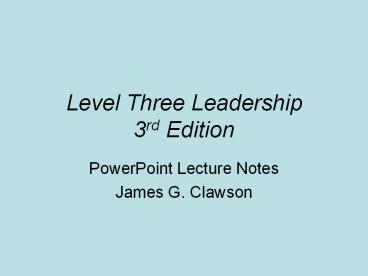Level Three Leadership 3rd Edition PowerPoint Lecture Notes PowerPoint PPT Presentation
1 / 12
Title: Level Three Leadership 3rd Edition PowerPoint Lecture Notes
1
Level Three Leadership3rd Edition
- PowerPoint Lecture Notes
- James G. Clawson
2
Chapter 11
- Introduction
- Without strategy, leaders are ineffective they
have no direction, no purpose - Strategic thinking is especially important today,
during the upheavals that accompany the shift
from Industrial Age to Information Age - Great leadership begins with great dreams
without the ability to develop powerful strategic
dreams, leaders abilities are undermined.
Strategists dreams are of the external kind,
typically, not the internal dreams discussed in
the resonance chapter.
3
- Definitions
- Strategic issue any issue that affects your
ability to develop and maintain a competitive
advantage - A competitive advantage has three components
- It adds superior value
- It is difficult to imitate
- It enhances your own flexibility
4
- Strategic challenges and issues occur in three
domains (this is another way in which this is
level three leadership. - The organization
- The work group (every unit can be outsourced in
todays world) - The individual (every persons job is at risk)
5
- Fundamentals of Strategic Thinking
- Strategy is the management of natural
competition. (Henderson) - Several models for understanding strategic
thinking - Fit Models. These models emphasize the
importance of finding appropriate niches in the
marketplace and optimal times to compete - Andrews nine criteria for evaluating the
strength of corporate strategies - SWOT (Strengths, Weaknesses, Opportunities,
Threats) - Porters Five Forces Model
- Porters Generic Value Chain
- Core Capabilities
6
- Intent Model. This model focuses on using core
capabilities to develop a strategic advantage at
some point in the future. It depends on both
having a vision and having the determination and
resources to bring that vision to pass - Ecological Model. This model proposes that in a
global marketplace, two companies may be
competitors in one region and collaborators in
another therefore they have a complex,
ecological relationship rather than a simple
business is war opposition. Strategy should
acknowledge this complexity and explore
objectives other than elimination of the
competition - Innovators Dilemma. Key measure is percent
utilization of products features. Rational
decision making encourages one not to compete
with low tech, unsophisticated, low margin
competitors.
7
- Experience Economy. Pine and Gilmore argue for
phases in economic history. Time between phases
and the margins each major focus brought have
diminished dramatically. Now that margins on
services are declining world wide, they argue
that people are paying high margins for
experiences things that are gone once the
moment has past, with no real value added except
the experience and its memory. This seems to be
true in any industry where customers can get
competitive goods and services, the experience is
the difference defining where customers will go
next.
8
- Good to Great. Jim Collins follows up his
co-authored blockbuster, Built to Last, with Good
to Great that argues for six differentiators
among 1600 company sample in which only 11 made
the jump from good to great over thirty years.
Level Five Leadership (which has nothing to do
with our frameworkits only the recognition of
levels in an organization with a somewhat
arbitrary definition of the superior executive,
one with will and humility), first who then what,
confront the brutal facts, hedgehog concept,
culture of discipline, and technology
accelerators.
9
- Scenario Building. The concept developed at
Royal Dutch Shell in the 70s to anticipate
alternative possible futures and then to watch
for them in the news to track which one was
developing. Each possible (NOT best case and
worst case) scenario has strategic implications
for a company.
10
- Strategic conversations. Learning to use the
scientific method including observations, data
collection, analysis, and using that data to make
decisions creates a basis for good strategic
conversations. This model omits the notion of a
creative genius that can inductively construct
the data in new ways to find leapfrogging
strategies. - Systems Perspective. The ability to see how the
various forces and components of an industry fit
together - Focus on Intent. Without clear intent, strategy
will vacillate - Intelligent Opportunism. Finding, through
careful analysis, the profitable places in which
to do business - Timing.
- Hypothesis. Implementation of intent must be
based on a hypothesis about cause and effect
relationships in the industry
11
Chapter 12
- Developing strategic thinking is hard, continuous
work. Sadly, many--most executives in my
experience--seem to get confused when talking
about strategy. Heres a simple framework for
helping keep the various elements of strategy
clear. These all can occur at the three levels,
organizational, work group, and individual. It
has five parts - Mission Statement. An explanation of why the
organization exists what business it is in, and
for what reason. Dont waste time on committee
generated mission statements that are generic and
demotivating. to provide world class goods and
services to our customer with a maximal profit to
our shareholders. One short phrase, 2-10 words.
12
- Vision Statement. Describes where the
organization is going, through a vivid, often
metaphorical description of the organizations
long-term goal - Values Statement. Outlines how the organization
will go about its work what means to the end
will and will not be tolerated - Strategy. The path of choices the organization
will make in moving toward its vision. This is
often the longest section. - Operating Goals. The periodic milestones and
objectives the organization will use to monitor
the progress of its strategy. Often mistook for
strategy in response to twenty-something analysts
from Wall Street whove never run anything.

